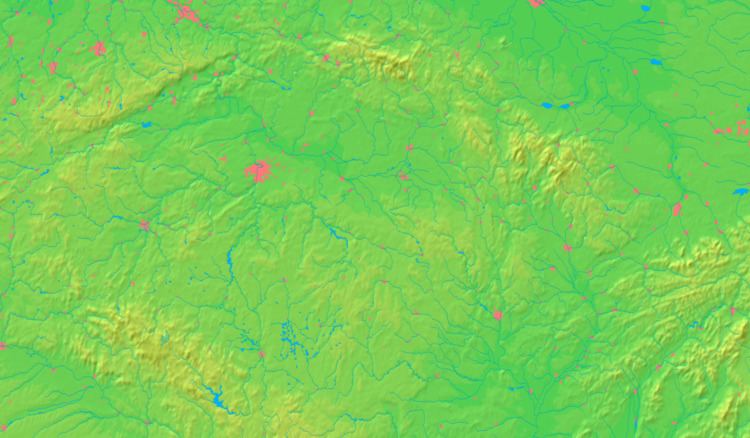- summer (DST) + 1 Local time Wednesday 8:12 AM Postal code 798 11 | Area 6.22 km² Area code (+420) 582 | |
 | ||
Weather 9°C, Wind NW at 8 km/h, 86% Humidity | ||
elezni n p ejezd a d 97 prost jov vrahovice rail crossing prostejov vrahovice
Vrahovice is a village in the Olomouc Region of the Czech Republic, near Prostějov, founded in 1337. It is one of the seven administrative divisions of the city of Prostějov, with a population of roughly 3,400 inhabitants.
Contents
- elezni n p ejezd a d 97 prost jov vrahovice rail crossing prostejov vrahovice
- Map of Vrahovice 798 11 ProstC49Bjov Czechia
- Vrahovice
- History
- Geography
- Administration
- Demographics
- Sights
- Education
- Transport
- Sports
- In popular culture
- Important natives and inhabitants
- Voluntary associations
- References
Map of Vrahovice, 798 11 Prost%C4%9Bjov, Czechia
Vrahovice
History
The village was first mentioned in 1337. The first mention of a church in Vrahovice was in 1370. The church was destroyed in a large fire in 1587. A church constructed shortly after the fire was used until 1831, when it was destroyed and replaced by a new one which was built between 1831-1836 and financed by Jan Josef Count Seilern, the owner of the Kralice domain.
A village by the name of Trpenovice (now known as Trpinky), with a written history dating back to 1349, was combined with Vrahovice in 1466. Between 1960-1973, Vrahovice also included the village of Čechůvky.
During its long history, Vrahovice passed through the hands of many owners. In 1725, Jan Bedrich Seilern bought Vrahovice. The Seilern family became the last to possess the village.
The first mayor of Vrahovice was Jan Frébort, who took office in 1848. The village experienced significant development during the interwar period, under the leadership of mayor Josef Stříž, when roads to Prostějov and Vrbátky and a new city hall were built. During World War II, occupying Nazi forces built an observation point on the hill above Vrahovice, controlling the railway. After World War II, there was an internment camp in the village for Germans from the Prostějov region awaiting transfer to Germany.
On 9 December 2004, five people were killed in the village when a truck carrying soldiers crashed into a train.
Geography
Vrahovice is located in Central Moravia. It lies in the Hornomoravský úval. The rivers Romže, Hloučela and Valová flow through Vrahovice. The point in Vrahovice is Vrbatecký kopec (known as Vrbák in the local dialect).
Administration
Between 1950 and 1954, and from 1973 until the present day, Vrahovice has been a part of Prostějov. Since the 1990s there have been advocates for its separation.
Demographics
According to the 2001 census, Vrahovice had 3,402 inhabitants.
Sights
Education
The village is home to a primary school dating back to the 19th century.
Transport
Vrahovice has a common integrated transport system with Prostějov. Bus routes from Prostějov to Přerov and Tovačov run through the village. Vrahovice is located on the train route from Nezamyslice to Olomouc. The village train station was built in 1946.
Sports
There is no professional sports team in Vrahovice. In 1930, a football team, SK Vrahovice, was established, but after the 1948 communist coup d'état, the team was banned. Its players became members of another voluntary football association, Sokol Vrahovice, which exists to this day.
In 2012, an amateur dragonboat team, Vrahovická sací jednotka, was established.
In popular culture
Jiří Bigas wrote a book, Vrahovice 119, about a village in the Sudetenland after the Second World War. He said he named the book Vrahovice because he knew the village from his childhood.
Important natives and inhabitants
Musicians Zdeněk Tylšar and Bedřich Tylšar were born in the village, and linguist Dr. František Kopečný lived there for many years. Football player Rostislav Václavíček was born in Vrahovice and played football for the local team at the beginning of his career.
Other notable natives:
Voluntary associations
In Vrahovice there are many clubs, such as Sokol, the Volunteer fire department and Spolek za staré Vrahovice, an association dedicated to local history research, environmental protection, and the promotion of the village. It has engaged in the process of giving new names to streets. The streets have been named after important Vrahovice inhabitants - Josef Stříž, František Kopečný and Zdeněk Tylšar. Today Spolek za staré Vrahovice is creating a new park, "Arboretum Vrahovice".
